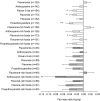Higher dietary flavonoid intakes are associated with lower objectively measured body composition in women: evidence from discordant monozygotic twins
- PMID: 28100511
- PMCID: PMC5320412
- DOI: 10.3945/ajcn.116.144394
Higher dietary flavonoid intakes are associated with lower objectively measured body composition in women: evidence from discordant monozygotic twins
Abstract
Background: Although dietary flavonoid intake has been associated with less weight gain, there are limited data on its impact on fat mass, and to our knowledge, the contribution of genetic factors to this relation has not previously been assessed.Objective: We examined the associations between flavonoid intakes and fat mass.Design: In a study of 2734 healthy, female twins aged 18-83 y from the TwinsUK registry, intakes of total flavonoids and 7 subclasses (flavanones, anthocyanins, flavan-3-ols, flavonols, flavones, polymers, and proanthocyanidins) were calculated with the use of food-frequency questionnaires. Measures of dual-energy X-ray absorptiometry-derived fat mass included the limb-to-trunk fat mass ratio (FMR), fat mass index, and central fat mass index.Results: In cross-sectional multivariable analyses, higher intake of anthocyanins, flavonols, and proanthocyanidins were associated with a lower FMR with mean ± SE differences between extreme quintiles of -0.03 ± 0.02 (P-trend = 0.02), -0.03 ± 0.02 (P-trend = 0.03), and -0.05 ± 0.02 (P-trend < 0.01), respectively. These associations were not markedly changed after further adjustment for fiber and total fruit and vegetable intakes. In monozygotic, intake-discordant twin pairs, twins with higher intakes of flavan-3-ols (n = 154, P = 0.03), flavonols (n = 173, P = 0.03), and proanthocyanidins (n = 172, P < 0.01) had a significantly lower FMR than that of their co-twins with within-pair differences of 3-4%. Furthermore, in confirmatory food-based analyses, twins with higher intakes of flavonol-rich foods (onions, tea, and pears; P = 0.01) and proanthocyanidin-rich foods (apples and cocoa drinks; P = 0.04) and, in younger participants (aged <50 y) only, of anthocyanin-rich foods (berries, pears, grapes, and wine; P = 0.01) had a 3-9% lower FMR than that of their co-twins.Conclusions: These data suggest that higher habitual intake of a number of flavonoids, including anthocyanins, flavan-3-ols, flavonols, and proanthocyanidins, are associated with lower fat mass independent of shared genetic and common environmental factors. Intervention trials are needed to further examine the effect of flavonoid-rich foods on body composition.
Keywords: body composition; diet; fat distribution; flavonoids; twins.
Figures


Similar articles
-
Higher dietary anthocyanin and flavonol intakes are associated with anti-inflammatory effects in a population of US adults.Am J Clin Nutr. 2015 Jul;102(1):172-81. doi: 10.3945/ajcn.115.108555. Epub 2015 May 27. Am J Clin Nutr. 2015. PMID: 26016863 Free PMC article.
-
Habitual intake of flavonoid subclasses and risk of colorectal cancer in 2 large prospective cohorts.Am J Clin Nutr. 2016 Jan;103(1):184-91. doi: 10.3945/ajcn.115.117507. Epub 2015 Nov 4. Am J Clin Nutr. 2016. PMID: 26537935 Free PMC article.
-
Habitual intake of dietary flavonoids and risk of Parkinson disease.Neurology. 2012 Apr 10;78(15):1138-45. doi: 10.1212/WNL.0b013e31824f7fc4. Epub 2012 Apr 4. Neurology. 2012. PMID: 22491871 Free PMC article.
-
The role of metabolism (and the microbiome) in defining the clinical efficacy of dietary flavonoids.Am J Clin Nutr. 2017 Jan;105(1):10-22. doi: 10.3945/ajcn.116.136051. Epub 2016 Nov 23. Am J Clin Nutr. 2017. PMID: 27881391 Free PMC article. Review.
-
Flavonoid subclasses and type 2 diabetes mellitus risk: a meta-analysis of prospective cohort studies.Crit Rev Food Sci Nutr. 2019;59(17):2850-2862. doi: 10.1080/10408398.2018.1476964. Epub 2019 Jan 21. Crit Rev Food Sci Nutr. 2019. PMID: 29768032 Review.
Cited by
-
Tart Cherry Concentrate Does Not Alter the Gut Microbiome, Glycaemic Control or Systemic Inflammation in a Middle-Aged Population.Nutrients. 2019 May 13;11(5):1063. doi: 10.3390/nu11051063. Nutrients. 2019. PMID: 31085979 Free PMC article. Clinical Trial.
-
A Selective Role of Dietary Anthocyanins and Flavan-3-ols in Reducing the Risk of Type 2 Diabetes Mellitus: A Review of Recent Evidence.Nutrients. 2019 Apr 13;11(4):841. doi: 10.3390/nu11040841. Nutrients. 2019. PMID: 31013914 Free PMC article. Review.
-
The role of the gut microbiome in the association between habitual anthocyanin intake and visceral abdominal fat in population-level analysis.Am J Clin Nutr. 2020 Feb 1;111(2):340-350. doi: 10.1093/ajcn/nqz299. Am J Clin Nutr. 2020. PMID: 31826255 Free PMC article.
-
Proanthocyanidins Should Be a Candidate in the Treatment of Cancer, Cardiovascular Diseases and Lipid Metabolic Disorder.Molecules. 2020 Dec 16;25(24):5971. doi: 10.3390/molecules25245971. Molecules. 2020. PMID: 33339407 Free PMC article. Review.
-
Five blueberry anthocyanins and their antioxidant, hypoglycemic, and hypolipidemic effects in vitro.Front Nutr. 2023 May 18;10:1172982. doi: 10.3389/fnut.2023.1172982. eCollection 2023. Front Nutr. 2023. PMID: 37275633 Free PMC article.
References
-
- Hughes LA, Arts IC, Ambergen T, Brants HA, Dagnelie PC, Goldbohm RA, van den Brandt PA, Weijenberg MP, Netherlands Cohort S. Higher dietary flavone, flavonol, and catechin intakes are associated with less of an increase in BMI over time in women: a longitudinal analysis from the Netherlands Cohort Study. Am J Clin Nutr 2008;88:1341–52. - PubMed
-
- Wang S, Noh SK, Koo SI. Green tea catechins inhibit pancreatic phospholipase A(2) and intestinal absorption of lipids in ovariectomized rats. J Nutr Biochem 2006;17:492–8. - PubMed
-
- Friedrich M, Petzke KJ, Raederstorff D, Wolfram S, Klaus S. Acute effects of epigallocatechin gallate from green tea on oxidation and tissue incorporation of dietary lipids in mice fed a high-fat diet. Int J Obes (Lond) 2012;36:735–43. - PubMed
-
- Wolfram S, Raederstorff D, Wang Y, Teixeira SR, Elste V, Weber P. TEAVIGO (epigallocatechin gallate) supplementation prevents obesity in rodents by reducing adipose tissue mass. Ann Nutr Metab 2005;49:54–63. - PubMed
Publication types
MeSH terms
Substances
Grants and funding
LinkOut - more resources
Full Text Sources
Other Literature Sources

